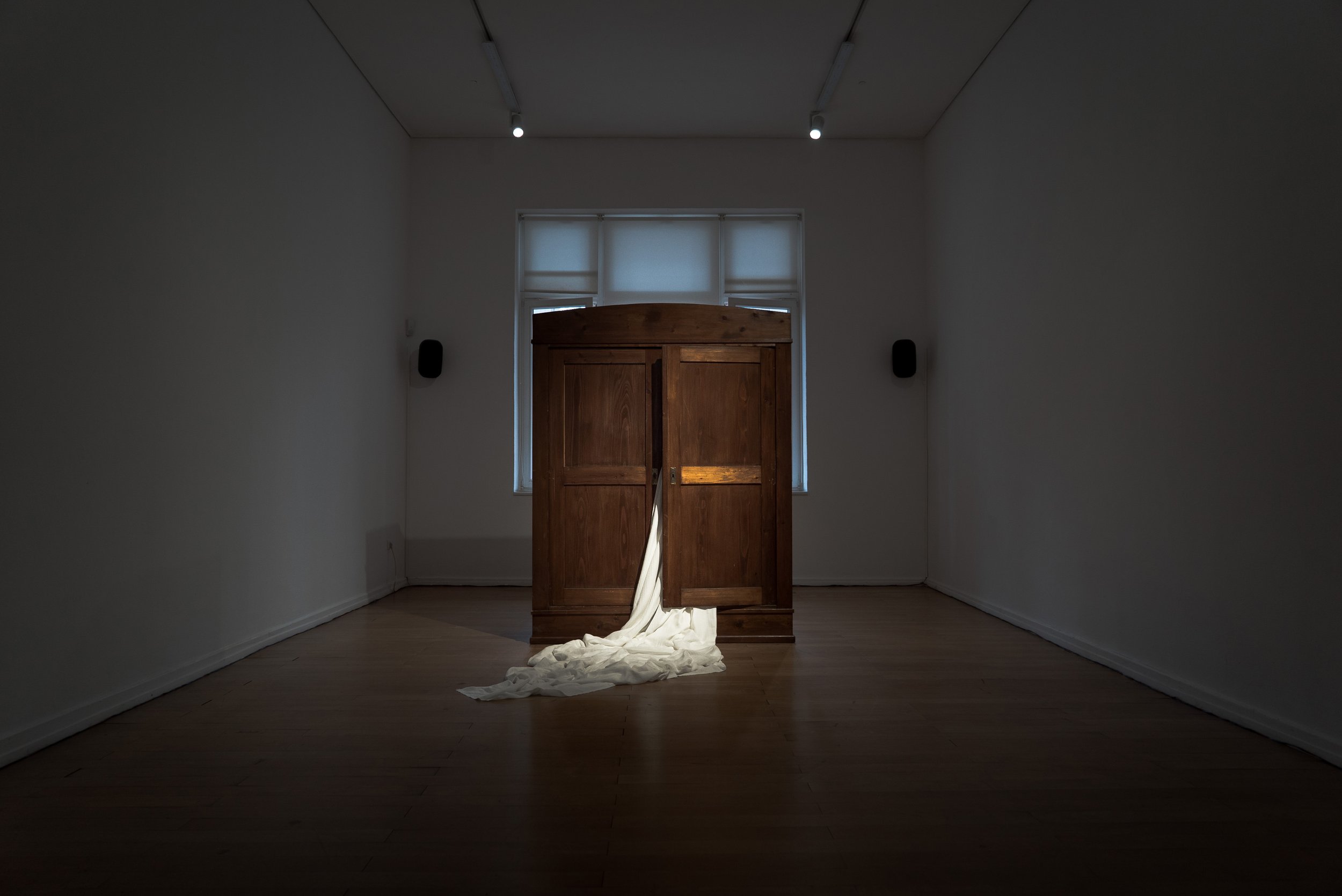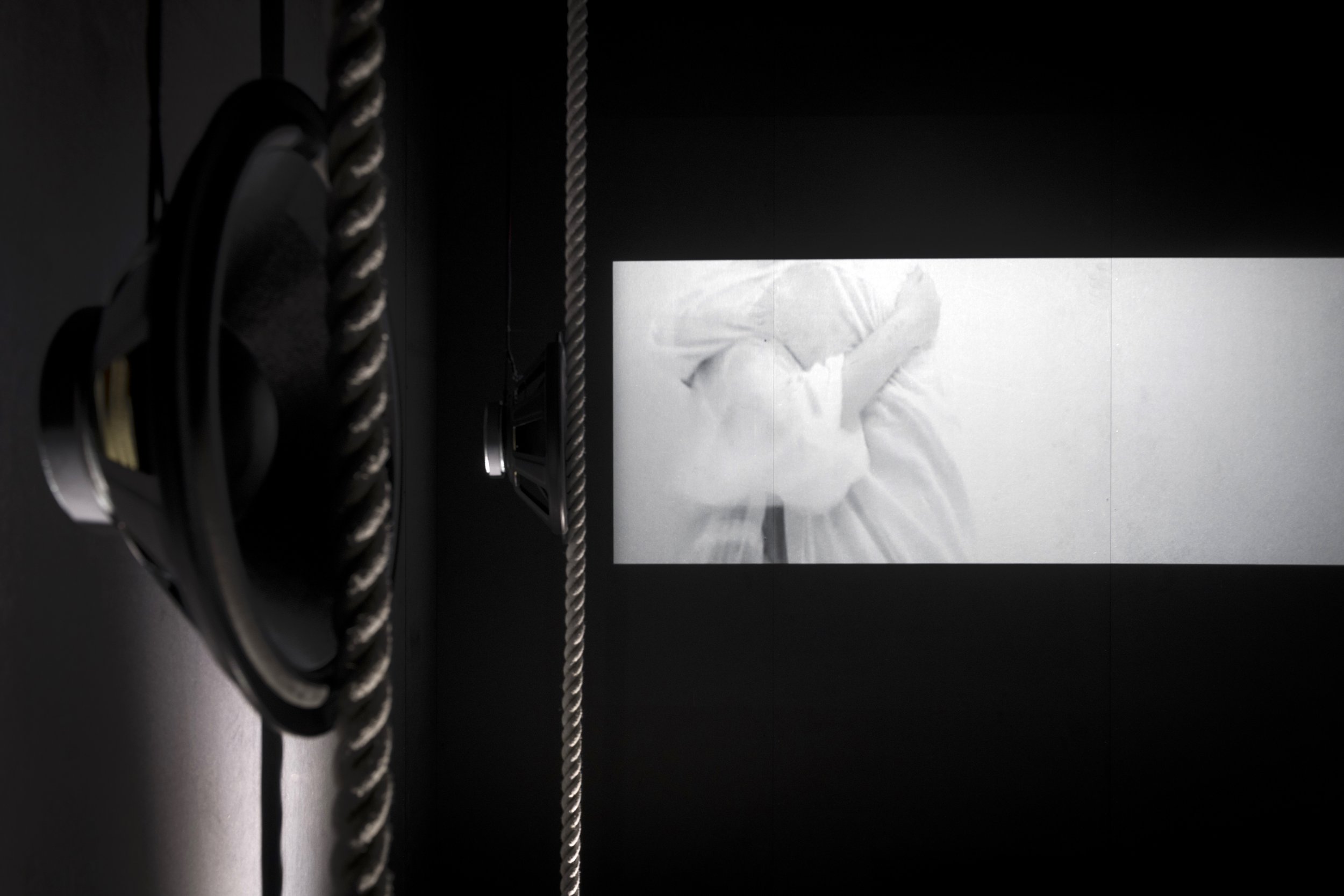“Pain, unspecified”, Nassauischer Kunstverein Wiesbaden - Centre for Contemporary Art, Wiesbaden, Germany, 2022 (Photo: Hyunju Oh)
프랑크푸르트 현대미술과 신음악 포럼인 KunstKulturKirche Allerheiligen에서 열린 오현주 개인전 “liebe.mutter”
2024년 6월 28일, 도로테아 에를벨레-퀴스터 교수의 전시 서문
“Pain, unspecified”(상세불명의 통증). 이는 우리가 이곳 KunstKulturKirche Allerheiligen에서 목격한 오현주 작가의 퍼포먼스 제목입니다. 퍼포먼스와 사운드 설치 작품으로 구성된 'liebe.mutter' (dear.mother) 전시는 아직 말하지 못한 이야기를 들려주며 모성에 대한 이미지를 되돌아보게 합니다. 그리고 그 이미지는 이곳에서 함께 살아납니다.
“Pain, unspecified”. 특정할 수 없는 것, 무형의 것이 고통을 고통으로 만듭니다. 통증은 헤아릴 수 없습니다. 대상이 없다는 특징을 가지고 있습니다. 고통에는 대상이 없습니다. 정의하기 어려운 고통, 이것은 표현과 전달을 갈구합니다. 여기 이 퍼포먼스에서 우리는 두 손의 움직임, 점점 커져가는 균열을 발견할 수 있었습니다. 오현주 작가는 바닥에 펼쳐진 종이 위에 무릎을 꿇습니다. 우리는 그녀의 손을 따라갑니다. 오른손으로 물컵을 잡습니다. 조심스럽게 물을 부어 바닥에 퍼트립니다. 젖어진 종이는 다시 한 장 한 장 찢어집니다. 쏟아지는 물에는 해방감과 치유력이 있습니다. 그러나 돌은 여전히 그곳에 남아 있습니다. 눈물을 흘리는 의식. 언어를 통해 정의할 수 없는 이 고통은 신체 언어가 됩니다. 몸의 내적 언어로서의 고통은 몸과 함께 몸 밖으로 전달됩니다.
“Pain, unspecified”, KunstKulturKirche Allerheiligen, Frankfurt am Main, Deutschland, 2024 (Photo: Thomas Orban)
“Pain, unspecified”, KunstKulturKirche Allerheiligen, Frankfurt am Main, Deutschland, 2024 (Photo: Thomas Orban)
오현주 작가의 2019년 작 "Pain, unspecified" (상세불명의 통증)는 이 교회에서의 퍼포먼스를 통해 새로운 맥락으로 재탄생했습니다. 고통이 성소의 십자가에서 출구를 찾아 쏟아져 나올 때까지 그 긴 길은 무한히 펼쳐집니다. 교회에서 고통은 보통 전례 중의 기도로써 큰 소리로 표현되며, 이는 제단 위의 십자가에 그려집니다. 여기서 빛은 위에서부터 빛의 원뿔을 통해 십자가 위로 흘러내립니다. 애도는 유대-기독교의 기도 언어에 깊은 뿌리를 두고 있습니다. “나의 하느님, 나의 하느님, 왜 나를 버리셨습니까?” 시편 22편에도 이와 같은 구절이 있습니다. “나는 물 같이 쏟아졌으며, 내 모든 뼈는 어그러졌으며, 내 마음은 밀랍 내 속에서 녹았나이다” 쏟아지는 고통. 이 퍼포먼스에서 고통은 애통으로 십자가를 향하는 것이 아닌, 제단에서 밖으로 향합니다. 동시에 시선의 방향은 아버지, 어머니, 하느님을 향합니다.
“Pain, unspecified”, Nassauischer Kunstverein Wiesbaden - Centre for Contemporary Art, Wiesbaden, Germany, 2022 (Photo: Hyunju Oh)
우리는 오늘 이 퍼포먼스를 “liebe.mutter” (사랑하는.어머니) 전시회의 맥락에서도 볼 수 있습니다. 이것은 모성 고통과의 연결을 요구합니다. 어린 시절의 고통. 불특정. 그 고통은 사랑일까요, 연결일까요, 눈물일까요. 아이가 말하는 소리가 들립니다: 어머니가 아파요. 당신의 아이. 그리고 어머니의 음성을 듣습니다: 사랑하는 아이야, 너는 내 안에서 아프구나. 이것은 점점 더 커져가는 균열입니다. 당신의 어머니. 찬장에 숨겨진 아이의 목소리(“hier, anders” - 오디오 드라마 설치 여기, 다른 곳에서)의 물음은 이미 함께 그 안에 담겨 있습니다: “여기가 어딘가요? 난 어디에 있는 건가요? 그곳은 밝은가요? 그곳은 잔인한가요?”
“hier, anderswo”, KunstKulturKirche Allerheiligen, Frankfurt am Main, Deutschland, 2024 (Photo: Thomas Orban)
몇 년 전 마인츠에서 오현주 작가의 퍼포먼스 "Pain, unspecified"를 처음 봤을 때, 한국 민중운동과 신학의 맥락에서 배웠던 ‘한’이라는 단어가 떠올랐습니다. 여기서 '한'은 군사독재 하에서 민중들이 겪은 말로 다할 수 없는 고통을 의미합니다. 한국 친구들에 따르면 '한'은 일상에서 고통에 쓰이지 않는다고 합니다. '한'은 민중항쟁으로 자식을 잃은 어머니의 말 못할 고통, 민중의 육체적 고통입니다. 번역할 수 없는. 한. 반란. 동요. 분노. 고통. 불의에 맞서는 어머니. 종이의 눈물을 통해 어머니 몸의 눈물.
정의할 수 없는 것, 지극히 개인적인 것은 타인의 고통에 열려 있으면서 외부화 될 수 있는 방식입니다. 그리고 고통을 표현하는 것은 예술이자 생존의 예술입니다. 작가 오현주는 소리를 '찢어지는 종이'에서 신체의 언어를 찾습니다. 퍼포먼스 "Pain, unspecified"는 프랑크푸르트에서 활동하는 여러 수상 경력을 가진 아티스트의 다면적인 면모를 한데 모은 작품입니다: 그녀는 시인이자 퍼포먼스 아티스트, 머티리얼 아티스트, 사운드 아티스트입니다.
“Ein Brief”, KunstKulturKirche Allerheiligen, Frankfurt am Main, Deutschland, 2024 (Photo: Jens Gerberg)
“Ein Brief”, KunstKulturKirche Allerheiligen, Frankfurt am Main, Deutschland, 2024 (Photo: Jens Gerberg)
“Unterm Schaten”, KunstKulturKirche Allerheiligen, Frankfurt am Main, Deutschland, 2024 (Photo: Jens Gerberg)
우리는 지금 사운드 설치물로 둘러싸인 KunstKulturKirche Allerheiligen에 있습니다. 교회는 하나의 청음실이 됩니다. 두 작품 “Unterm Schatten”(어둠 아래)과 “Ein Brief”(한 편지)는 초연작입니다. “Unterm Schatten"(그림자 아래, 2024)에서는 조심스럽게 접힌 담요가 열린 교회 공간의 의자 위에 쌓여 있습니다. 흰색. 깨끗한. 그들은 나를 덮는다. 어머니가 나를 덮어주었습니다. 숨쉬는 동굴. “Unterm Schatten"에는 무엇이 숨겨져 있고 무엇이 소리로 나올 수 있을까요?
“Ein Brief” (한 편지, 2024)는 오래된 창문에 음향으로 설치된 작은 오디오 설치물입니다. 우리는 서로 다른 언어의 음성 편지를 듣게 됩니다. 여기서 편지의 수취인은 특정되어 있습니다: 사랑하는 어머니. 나머지는 우리의 행위가 필요합니다. 침묵 속에서, 귀를 기울이면 편지는 조용한 내면의 기도가 됩니다. 사랑하는 어머니. 당신의 자녀 또는 딸. 인사말 속에 편지의 받는 사람이 담겨 있습니다. 그녀는 부재중입니다. 우리는 아이의 목소리만 듣습니다. 작품 “Ein Brief”(한 편지)는 어머니를 향하고 어머니를 찾습니다.
"사랑하는 어머니"라는 인사말은 여기서 잠시 동안 하느님의 어머니를 향한 연설이 되었습니다. 이곳 KunstKulturKirchen 입구에 위치한 작은 공간의 성모상이 눈에 들어옵니다. 하느님의 어머니 마리아는 사운드 설치를 통해 존재감을 드러냅니다. 교회에서 우리는 보통 우리 아버지, 친애하는 아버지라고 말합니다. 하늘에 계신 아버지. 여기 지상에 계신 어머니. 사랑하는 어머니. 부재중인 어머니에게 보내는 주소. 기도의 편지.
"liebe.mutter" (사랑하는.어머니). 이 전시 제목은 두 개의 단어를 조합한 말장난이기도 합니다. 두 단어는 점으로 구분되어 있습니다. 숨을 고르기 위한 쉼표. 이 두 단어는 그 자체로 생명을 얻습니다. 사랑에는 본질적인 가치가 있습니다. 우리는 거의 항상 어머니를 호칭의 한 형태로 듣습니다. 사랑.어머니. 점으로 거꾸로 읽을 수도 있습니다: 어머니.사랑
퍼포먼스, 사운드, 침묵을 넘나드는 멀티 아티스트 오현주는 "liebe.mutter" 전시에서 설치 작품에 자유로운 공간을 연출합니다. 이를 통해 모성에 대한 이미지를 확장하고 고정관념에서 벗어나게 합니다. 사랑하는.어머니.
"Mutterboden"은 오현주 작가가 현재 작업하고 있는 주제입니다. 이 침묵의 사운드 아티스트는 '어머니'라는 실존적 주제의 양면성, 그리움, 강인함을 숨소리, 말의 파편, 상상적 사운드 이미지로 변환합니다. 이를 통해 그녀는 진부한 어머니의 이미지를 재현하는 것을 거부합니다. 이에 귀 기울이기 위해 우리는 여기 KunstKulturKirche에 초대된 것입니다.
Prof. Dr. Dorothea Erbele-Küster (독일 국립 요하네스 구텐베르크 대학교)























